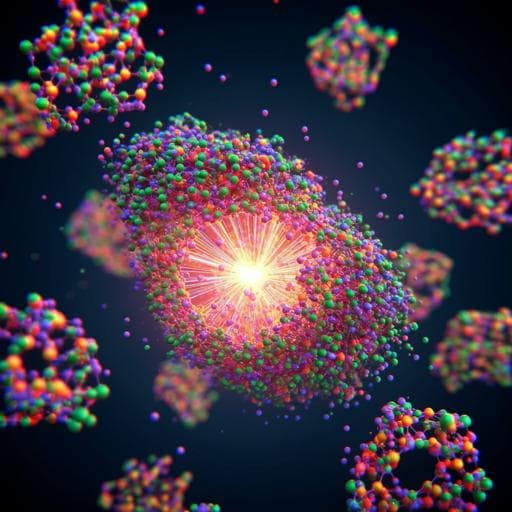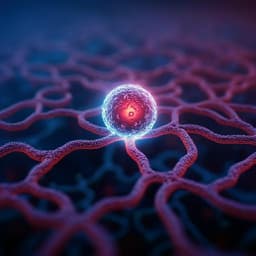
Chemistry
Connecting energetics to dynamics in particle growth by oriented attachment using real-time observations
L. Liu, E. Nakouzi, et al.
This research by Lili Liu and colleagues explores the fascinating crystal growth mechanism of oriented attachment (OA) in ZnO nanocrystals. The study uncovers how electrostatic forces and dipolar interactions play a significant role in driving OA, with the capacity to influence particle alignment at distances greater than 5 nm. Discover the profound dynamics of nanocrystal assembly revealed through in situ TEM observations combined with simulations.
~3 min • Beginner • English
Introduction
Oriented attachment (OA) is a crystal growth mechanism where nanoparticles align crystallographically and fuse, shaping diverse morphologies across many materials. Despite direct observations of OA in various systems, the quantitative relationships among surface chemistry, solvent structure, interparticle forces, and particle dynamics remain unclear. Prior in situ microscopy and AFM force studies revealed approach, rotation, and jump-to-contact behaviors, but the specific force components, their ranges, and how they bias alignment are not well established. This study addresses these gaps using ZnO as a model polar oxide, combining liquid-phase TEM to track real-time dynamics with theoretical modeling to extract interparticle potentials and connect them to electrostatic, ion-correlation, van der Waals, and dipolar interactions. The goal is to determine how long- and short-range forces coordinate translation and rotation to produce OA-dominated growth.
Literature Review
OA has been reported in oxides, oxyhydroxides, metal chalcogenides, metals, and carbonates. In situ LP-TEM studies on iron oxide and Au revealed rotation to alignment followed by jump-to-contact, and ligand-coated systems exhibited short-range steric barriers and solvent-separated minima. AFM-based force measurements on TiO2, ZnO, and mica probed direction-specific interactions and solution-structure effects. However, prior works often did not decompose the interaction potentials into underlying forces (e.g., van der Waals, dipole-dipole, ion-correlation), and MD simulations typically predict strong sub-nm hydration barriers and limited long-range interactions, conflicting with some experimental observations. This motivates a framework capable of capturing both short- and long-range solution-mediated interactions for ZnO, a polar material with an intrinsic dipole that may induce long-range torques and attractions.
Methodology
- Synthesis: ZnO nanoparticles were synthesized in methanol by reacting zinc acetate dihydrate (0.01 M) with KOH (0.03 M) at 60 °C for 2 h, then washed and dispersed in methanol.
- LP-TEM setup: Static liquid cells used Si3N4 membranes with 100 nm Au spacers; membranes were oxygen plasma cleaned. ~0.8 µL droplets were sealed between chips. Imaging performed on a Tecnai F20 (200 keV) with CCD capture at ~2 s/frame.
- Stabilizing ZnO under beam: In pure methanol or water, ZnO dissolved rapidly under LP-TEM. Adding Zn2+ (as zinc acetate) mitigated dissolution; at 1 mM Zn2+ dissolution was not observed, enabling long-timescale imaging.
- In situ observations: Particle approach, rotation, attachment, and post-contact neck elimination were recorded. Orientations were extracted using FFT-based analyses of lattice fringes. Particle tracking (position, area) used MATLAB algorithms.
- Ensemble statistics: The radial distribution function g(h) of edge-to-edge separation h was computed over frames, correcting for frame-edge truncation, yielding a quasi-steady distribution. The potential of mean force W(h) was obtained via inversion, W(h) = -kT ln g(h).
- Kinetics and diffusion: Assuming quasi-2D motion dominated by tangential diffusion near a membrane, the second-order attachment rate k11 was extracted from −dn/dt = k11 n^2, where n is the 2D monomer count in the imaging area. Mean squared displacements gave an average diffusion coefficient D ≈ 2.99 nm^2/s for particles of radius a ≈ 2.2 nm (much smaller than Stokes–Einstein bulk predictions). Stability ratio W = ko/k11 was computed with ko derived for quasi-2D hydrodynamics including hydrodynamic resistivity G(a,h) and effective viscosity μ near the interface.
- cDFT simulations: Interaction pressures (disjoining pressure) between ZnO facets in methanol with zinc acetate were computed for 0.5 nm ≤ h ≤ 8 nm. Primitive model (solvent as dielectric) and a full model (explicit neutral hard-sphere methanol plus mean-field ion–solvent interactions fit to solvation enthalpies) were used. Facet pairs included (0001)-(0001), (10-10)-(10-10), (0001)-(10-10), and (0001)-(000-1), considering aligned and misaligned surface charge patterns. Curvature effects were approximated via surface element integration for particles of radius ~2 nm.
- Langevin dynamics with dipoles: Translational and rotational Langevin dynamics for two 2.2 nm-radius spherical particles with dipole-dipole interactions were simulated to assess long-range attraction and torques. The dipole moment μ ≈ 779 D was estimated by fitting experimental W(h) at large separations to the asymptotic 2μ^2/(ε r^3) form (ε ≈ 32 for methanol; r = h + 2a). Thousands of trajectories starting at h = 20 nm were used to quantify alignment propensity (cosθ1 cosθ2).
Key Findings
- Direct in situ evidence of oriented attachment (OA): Particle pairs approached, rotated to reduce misorientation from ~43° to near 0°, then jumped to contact, forming single-crystal domains aligned along [001]. Alignment occurred ≥20 s before contact; post-contact necks vanished via rapid surface diffusion.
- Long-range interactions: Inverted RDFs revealed an attractive potential W(h) detectable out to ~10 nm edge-to-edge, with no appreciable barrier (< ~1 kT). Torques that drive alignment were evident starting at ~4.5–5 nm separation.
- Jump-to-contact distance: Particles jumped to contact at h = 1.08 ± 0.33 nm, consistent with other systems.
- Kinetics and diffusivity: The quasi-2D second-order attachment rate k11 ≈ 1.53 nm^2 s−1. Particle diffusivity D ≈ 2.99 nm^2/s for a ≈ 2.2 nm particles, ~10^6× smaller than Stokes–Einstein in bulk, reflecting strong confinement-induced drag near the membrane. The ideal quasi-2D coagulation rate ko ≈ 73.5 nm^2 s−1, giving stability ratio W ≈ 48, indicative of negligible to small barriers and diffusion-limited aggregation.
- Timescales: Estimated rotational timescale ~0.1 s vs translational ~60 s under quasi-2D confinement, allowing ample time for rotational alignment before close approach.
- cDFT results: Electrostatic, ion-correlation, solvation (packing), and van der Waals contributions yield small or no barriers. Full model predicts small barriers (~≤ kT nm−3) localized to h ≈ 1.0–1.5 nm for (0001)-(0001) and (0001)-(000-1); monotonic attraction for (10-10)-(10-10) and (0001)-(10-10). Including curvature (a ≈ 2 nm) gives a barrier ~kT at h ~1 nm for oppositely charged faces, consistent with experiments.
- Dipolar interactions: Langevin simulations with μ ≈ 779 D reproduce long-range attraction and alignment (cosθ1 cosθ2 → 1 as h decreases), matching the experimental W(h) at large h and explaining alignment prior to contact.
- OA predominance: In all resolvable cases (3/3), OA was observed; no evidence for distinct non-OA kinetic pathways, implying OA is statistically dominant under these conditions.
Discussion
The study links measured interparticle potentials to specific interactions and particle response dynamics in ZnO OA. Long-range attraction and torques cause particles to coalign well before the strong short-range attraction triggers jump-to-contact at ~1 nm. Quasi-2D confinement slows translation far more than rotation, enabling alignment to occur en route, resulting in OA as the dominant pathway without a significant energetic barrier. cDFT reconciles prior MD-predicted hydration barriers by showing that electrostatic double layers, ion correlations, solvation packing, and van der Waals forces collectively produce at most small, localized barriers, while Langevin modeling demonstrates that intrinsic dipole-dipole interactions in polar ZnO generate long-range forces and torques scaling as 1/r^3. These findings contrast with ligand-coated metallic systems where short-range steric barriers and solvent-separated minima dominate and attractions are limited to ~2 nm. Potential secondary influences include electron-beam effects (unlikely to induce long-range torques here), solvation-structure-induced oscillatory forces suggested by full cDFT, and confinement-enhanced dispersion interactions near the membranes. Together, the results explain how ZnO’s polarity and the confined hydrodynamic environment coordinate to favor OA-driven growth of nanorods.
Conclusion
This work establishes that ZnO nanoparticles experience long-range attractive interactions and aligning torques that pre-orient particles before close approach, leading to oriented attachment with negligible energetic barriers. Short-range solution-mediated forces (electrostatics, ion correlations, van der Waals, solvation) account for the jump-to-contact behavior at ~1 nm, while long-range dipole-dipole interactions explain alignment and attraction beyond ~5–10 nm. Quasi-2D confinement in LP-TEM produces markedly slower translation than rotation, enabling OA to dominate. The integrated approach—real-time LP-TEM, RDF inversion, cDFT, and Langevin dynamics—provides a quantitative framework for connecting energetics to dynamics in OA. Future work should test dipole-dependence across materials with varying polarities, probe solvation-structure contributions via AFM force spectroscopy and cryo-TEM, and systematically assess confinement effects by varying cell geometries and substrates.
Limitations
- LP-TEM confinement yields quasi-2D dynamics and anomalously low diffusivities, which differ from bulk solution behavior; membrane proximity and electron beam may influence interactions and kinetics.
- cDFT full-model artifacts include oscillatory disjoining pressures and sensitive dependence on charge-pattern alignment at large separations; representation of methanol as a neutral hard-sphere fluid with mean-field non-electrostatic interactions is approximate, and explicit dipolar solvent/association is neglected.
- cDFT is limited for h < 0.5–0.75 nm and does not include nanoparticle dipoles; validation against fully molecular models is challenging.
- Orientation tracking was possible in a limited number of events (3) due to imaging constraints, though ensemble statistics support conclusions.
- Potential confinement-enhanced dispersion and substrate effects were not isolated; broader parameter sweeps (salt, substrates, geometry) are needed to generalize.
Related Publications
Explore these studies to deepen your understanding of the subject.







